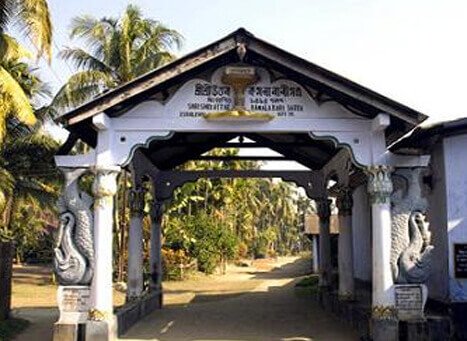
This Sattra belongs to the Nika Sanghati which gives leverage to Naam (the deity) as compared to the other components of the Sattra like Dev, Guru and Bhakat.
The Uttar Kamalabari Sattra is located in the central part of the Majuli Island. A pedestrian pathway connects to the main tarred road (built by the P.W.D.), which runs along the South-Western edge of the property. The Sattra campus extends over a large area. The entire area can be broadly classified under two categories, the site and the green setting around the site. All the components of the site are placed within a rectangular area. The land form of the site is flat and slightly elevated from the immediate surrounding. The site can be divided into the religious zone in the centre and the residential zone on the periphery, except the Eastern side which acts as the administrative zone. It accommodates all the activities related to religious, administrative and day to day life of the Sattra. It comprises of a prayer hall locally refered to as the 'Namghar', which is centrally located; residential units are situated in the formof row housing ('Hati') on all four cardinal directions for devotees except on the Eastern side. The entrance gate known as the 'Batchora' is located at the periphery on the South-Western side. The store rom known as the 'Bharal ghar' is located on the Eastern side of the site.
The museum and the treasury is located in the centre on the Southern side of the Namghar. The Sattradhikar's residence and office is located on the Eastern side. Store room for paddy is adjacent to the Sattradhikar's residence. Cowsheds, open spaces for daily activities (located on the front and on the rear of the Hattis) and small kitchen gardens are also found within the site. The site also has a water body or pond known as Pokhri. The setting of this Sattra consists of wet lands and dense vegetation. Most of the setting is covered with thick vegetation, aquatic plants and grass. Dense bamboo grooves and vegetation of mixed plant species are located around the water bodies. Thick vegetation is located along the edges of the site to create a natural buffer for the Sattra complex. The setting of this Sattra supports and helps to maintain the bio-diversity of this area. Any kindof construction activity is strictly barred in this area.
OCCUPANTS OF THE SATTRA
The occupants of the Sattra can be broadly classified into two categories the Sattradhikar and theb Bhakats. The Sattradhikar is the religious and the administrative head of the Sattra and all the devotees who stays permanently within the Sattra are known as Bhakats. They are responsible for different kinds of duties related to the Sattra activities. These duties varies from administrative, maintenance, religious, and religious cum cultural activities.
